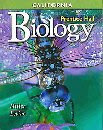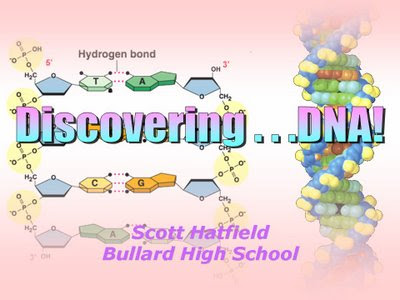 Parents and Students:
Parents and Students:Monday (Dec. 16th) began the final week of instruction for the Fall Semester.
This is a post to give everybody one last 'heads-up' about Finals week in Biology!
First of all, 'A Twist of Fate', an important 100-point project, was due on Friday (12/13), and no late work of any kind will be accepted after Wednesday (12/18)
This assignment is based on a reading describing the scientific detective story that led to the discovery of DNA's structure. The reading is adapted from an article by Michael Lemonick that appeared in the Feb. 17, 2003 issue of Time. That article can be read in its entirety on-line here. Students have been given an edited version of that article with terms to be defined and questions to address. The entire assignment can be found as a PDF file here.
Students are expected to define terms underlined in the article, and to answer four discussion questions according to the usual guidelines: complete sentences that refer to the original question and provide supporting evidence for the student's opinion. Responses should be typed or word-processed. It is not, however, necessary to submit the assignment to "Turnitin.com". (The district is no longer supporting this valuable resource, alas)
Secondly, students received a Study Guide for their 200-point Semester Final on Friday (12/14)
Students should be reviewing it and using it to identify any weaknesses, as well as working to submit any other outstanding work in the course by the end of instruction (Wednesday, 12/17). Should the student lose this Study Guide, the entire three pages of it can be found as a PDF file here.
Next, there will be a Study Session for BIOLOGY after-school on TUESDAY (12/17).
This Study Session will take place in my classroom (N-63). It will begin at 3:15 and end at 5:15 that evening. I realize it will be dark by the time this session is completed, but I assure parents and students that those who attend these session typically do better on the exams. And, if that's not enough of an incentive, students who attend not only receive valuable feedback as to what to expect on the test, but can earn up to 20 points of extra-credit.
The Biology Final will be given Wed. (the 18th) through Friday (the 20th)
There is no significant makeup period. Students need to attend their final exam period if they want significant time for their Final. Those who fail to attend without having their parent or guardian reach a prior understanding with Mr. Hatfield will be given an 'incomplete' in the course.
Finally, the Power Point with notes on DNA and Protein Synthesis is available on-line here:

The Power Point notes are available for download here.
A PDF of the Lecture Guide based on the Power Point notes is available here.










































